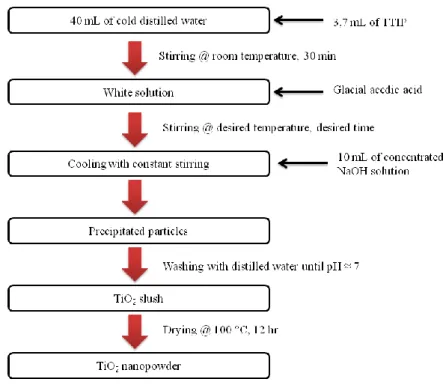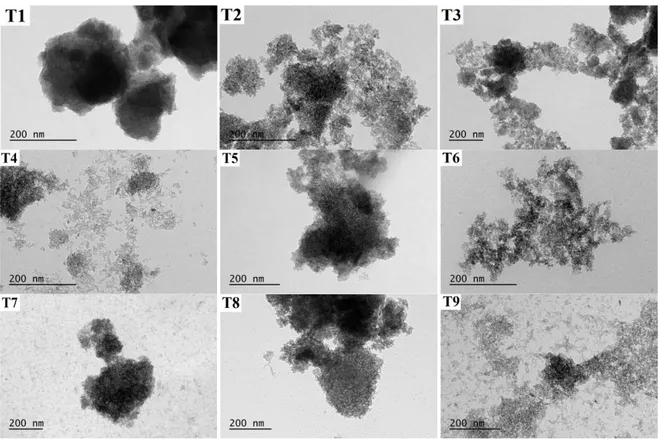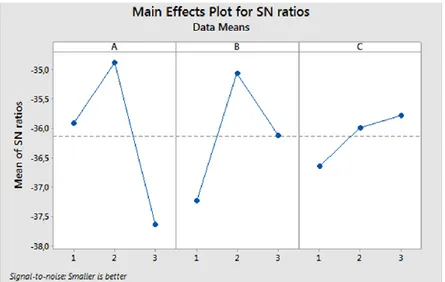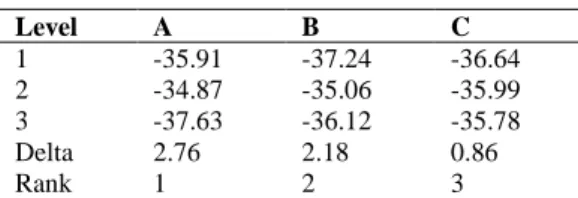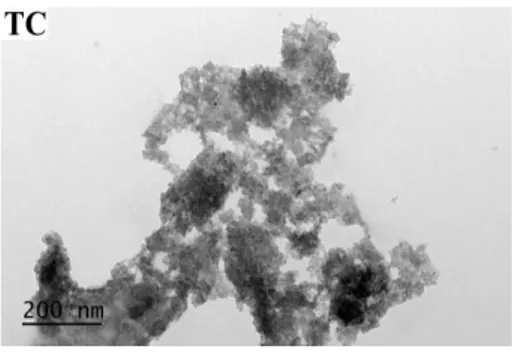*Corresponding Author:gamzekaranfil86@gmail.com
Anadolu Üniversitesi Bilim ve Teknoloji Dergisi A- Uygulamalı Bilimler ve Mühendislik Anadolu University Journal of Science and Technology A- Applied Sciences and Engineering 2017 - Volume: 18 Number: 3
Page: 705- 712
DOI: 10.18038/aubtda.277814
Received: 14 December 2016 Revised: 06 July 2017 Accepted: 09 August 2017
APPLICATION OF TAGUCHI METHOD FOR THE SYNTHESIS OF NANO-SIZED TiO2
POWDERS BY ACID-USED SOL-GEL METHOD Gamze KARANFİL CELEP 1,*, KEVSER DİNCER 2
1 Department of Energy Systems Engineering, Faculty of Engineering, Karamanoğlu Mehmetbey University,
Karaman, Turkey
2 Department of Mechanical Engineering, Faculty of Engineering, Selçuk University, Konya, Turkey
ABSTRACT
The acid-used sol-gel synthesis of nano-sized titania (TiO2) powders has been studied systematically to optimize the processing
parameters by Taguchi method that control crystallite size. In addition, crystallite and particle size of TiO2 powders were examined
by X-ray diffraction (XRD) and transmission electron microscopy (TEM). For this purpose, the amount of acid, reaction temperature and reaction time were determined as control parameters. In order to achieve these objectives, Taguchi’s L9 orthogonal
design (3 parameter, 3 level) was used for the experiential design. In order to determine the optimal synthesis conditions for nano-sized TiO2 powders, the signal-to-noise (S/N) ratio was used, which was calculated from crystallite size of the nano-sized TiO2
powders using "the-smaller-the-better" appoachment. Besides, analysis of variance (ANOVA) was utilised to accomplish the statistical importance of the synthesis parameters. Experiments were fulfilled to verify the model at the chosen conditions and the particle size was determined according to XRD analysis as 46.98 nm. Moreover, the actual size of the synthesised nano-sized TiO2
powders with the average size was 51.41 nm. Therefore, the Taguchi optimization method was a main tool in the optimization of the nanosized TiO2 powders synthesis process with less experiential tests and slightly cost-efficient approachment.
Keywords: TiO2, Nano-sized material, Sol-gel, Taguchi method
1.INTRODUCTION
Nano-sized materials are in existence as crystal or powder forms with a dimension less than 100 nm and a high surface-to volume ratio [1]. Besides, nano-sized materials are significant for biomedical, communication, energy, electronic applications because of their good electrical, optical and magnetic properties that are different from their bulk counterparts [2]. Among them, nano-sized TiO2 powder is one
of the most significant particulate material using for various objectives, because of its great features of a high refractive index leading to a high keeping power and whiteness, nontoxicity, high oxidizing capability, chemical stability, relatively low production cost and easy availability in the market [3, 4]. TiO2
have been prepared by several physical and chemical deposition techniques such as chemical bath deposition, sol–gel, hydrothermal, spray pyrolysis, plasma oxidation, pulsed laser deposition etc [5–7]. Among these techniques, the sol–gel technique has many advantages when compared with the other methods, that is, it has a simple and cost-effective experiential array and also provides low temperature processing, nucleation and growth kinetics, homogeneity, reliability, controllability, reproducibility, etc [3]. An acid-used sol-gel method only behoves the use of the titanium precursor, acid and water. Alcohol was not used to dissolve the alkoxide/ another reagent to synthesise nano-sized TiO2 powders [8]. There
are many important parameters that are required to obtain desired size of nanoparticles in the synthesis of nano-sized TiO2 powders to be produced by the given technique. The relationships between the
factors are complicated, and the sol–gel process analysis to optimize the parameters is a time and labour depletive work. Therefore, the analysis using traditional experiential techniques are infertile [9]. Optimization of experiential design is an effective approach to minimize the number of experiential tests as well as the production cost. Therefore, Taguchi optimization method was used in this study. The
Taguchi optimization method is a simple and easier approach that ensures efficient solutions for the design, as it emphasizes an acquired performance characteristic value next to the intended value. Thus, important factors that have an important influence on the experiential conditions could be distinguished and the optimum performance value is specified [1].
In the present work, the Taguchi optimization method was implemented during the nano-sized TiO2
powders synthesis through the acid-used sol–gel technique. It is aspired to study the relationship between all of the main parameters at three levels on the average particles size of the nano-sized TiO2
powders without high number of experiential tests. The focal point is the optimization of synthesis parameters to procure the smallest nano-size of TiO2 powders.
2. MATERIALS and METHOD
2.1. Materials and Synthesis of TiO2 Nanopowders
In this study, the nano-sized TiO2 powders were synthesised through an acid-used sol–gel technique at
lower temperature with a easy instrument setup. The given chemicals were purchased from Sigma Aldrich and used without any further purification: Titanium (IV) isopropoxide (TTIP, 97%), glacial acetic acid (AA) and sodium hydroxide (NaOH). Freshly double distilled water was used through out the all experiments.
In a beaker, cold distilled water (40 ml) were taken and TTIP (3.7 ml) were abruptly supplemented and the beaker was encased. Instantly, the mixture was stirred for 30 minutes. After all this while, AA was supplemented and stayed under invariable stirring for desired time at the required temperature. After actualising the reaction, the heating was stopped and the solution was permitted to cool with invariable stirring. Then, the suspended particles were settled with concentrated NaOH solution (10 ml). The settled particles were washed with distilled water until a pH of 7 was achieved. Lastly, particles were permitted to precipitate and the surplus water was detract from the particles. The TiO2 slush was dried
in an oven at 100 °C for 12 hours. The dried powders were homogenised in a mortar [8]. Figure 1 shows the experiential procedure.
Karanfil Celep and Dincer / Anadolu Univ. J. of Sci. and Technology A – Appl. Sci. and Eng. 18 (3) – 2017
707
2.2. Experiential Design
In the present work, the Taguchi orthogonal array approachment was applied. All parameters that had important impact on the nano-sized TiO2 powders production were selected as well as their levels. The
amount of glacial acedic acid (mL), synthesis temperature (°C) and synthesis time (hr) were chosen as parameters at three varied levels. The amount of glacial acedic acid was varied from 1 to 9 mL, the synthesis temperature was varied from 70 to 90 °C and the synthesis time was within 2 to 4 hours. Table 1summarises all of the parameters and levels used in this experiment.
Table 1. Parameters and levels for Taguchi design of the nano-sized TiO2 powders
Synthesis parameters Levels
1 2 3
A The amount of AA (mL) 1 3 9
B The synthesis temperature (°C) 70 80 90
C The synthesis time (hr) 2 3 4
To analyze the impact of three parameters and their effects in three varied levels, 27 samples are behoved to be synthesized; but the experiential runs can be decreased by using the Taguchi optimization method [10]. In present work, a Taguchi experiential design with notation modified L9 (33) was selected to
optimize experiential conditions to utilize the crystallite size of TiO2 powders produced by acid-used
sol–gel technique under several synthesis factors. The modified orthogonal array of L9 designed by the
Taguchi optimization method which submits the experiential conditions is shown in Table 2. The samples were produced according to the modified L9 orthogonal array conditions.
Table 2. Modified L9 orthogonal array
Experiment No Codes A B C D 1 T1 1 1 1 1 2 T2 1 2 2 2 3 T3 1 3 3 3 4 T4 2 1 2 3 5 T5 2 2 3 1 6 T6 2 3 1 2 7 T7 3 1 3 2 8 T8 3 2 1 3 9 T9 3 3 2 1
According to the Taguchi optimization method, the optimization of obtained values was specified by comparing S/N ratio values. Besides, an consideration of the synthesis conditions was executed by ANOVA statistical method to study the relationships between all parameters towards the crystallite size of TiO2 powders as the responses.
2.3. Characterization
The structure of the sample was examined using a X-Ray diffractometer (XRD, Bruker D8 advance) with Cu Kα radiation (λ= 1.54059 Å) which was operated at 40kV voltage and 40 mA anode current. Data were collected in 2θ values from 10° to 80°. The morphology of the sample was observed by using JEOL JEM-2100 Transmission Electron Microscopy (TEM).
3. RESULTS and DISCUSSION
The XRD pattern of TiO2 nanopowders is shown in Figure 2. The existence of multiple diffraction peaks of A(101), A(112), A(211), A(204), R(110), R(101) and B(121) in the diffraction patterns revealed that all the powders were anatase (A), rutile (R) and brookite (B) phase, respectively (JCPDS-Card No. 00-021-1272 for anatase, 01-089-0554 for rutile and 00-029-1360 for brookite phase). All of these outcomes can be seen in Figure 2and they are in accordance with the literature [3, 8, 11].
10 20 30 40 50 60 70 80 (A 2 0 4 ) (A 2 1 1 ) (A 2 0 0 ) (A 1 1 2 ) (R 1 0 1 ) (B 1 2 1 ) (R 1 1 0 ) (T1) (T9) (T8) (T7) (T6) (T5) (T4) (T3) In ten sity 2Q (T2) (A 1 0 1 )
Figure 2. XRD pattern of TiO2 nanopowders
In order to investigate morphology of nanopowders, TEM images were taken that shown in Figure 3. The shape of TiO2 nanopowders is close to spherical, however, because of the aggregation of particles, the average size of TiO2 nanopowders could not be determined.
Figure 3. TEM images of TiO2 nanopowders
Performance characteristics chosen to be the optimization criterion are tripartited, the smaller the best, the nominal-the-best and the larger-the-best. The performance characteristic of the present work is the minimum crystal size, which belongs to the smaller the best characteristic and is calculated as follows [12]: 𝑆 𝑁⁄ = −10log(𝑛1∑𝑛𝑖=1𝑦𝑖2) (1)
Karanfil Celep and Dincer / Anadolu Univ. J. of Sci. and Technology A – Appl. Sci. and Eng. 18 (3) – 2017
709
where yi is the performance characteristic value calculated from the test and the unit of S/N is dB; the
number of the trials is n.
The crystal size of each specimen was calculated by using the width at full width at half-maximum (FWHM) of a peak applying the Scherrer equation for the anatase (101) plane:
𝑑 = 0.9𝜆
𝛽𝑐𝑜𝑠𝜃 (2)
where the crystal size (nm) is d, the wavelength of Cu Kα radiation (nm) is λ, the Bragg angle is θ and FWHM of diffraction peak is β.
The crystal size values estimated from XRD patterns and the calculated S/N ratios are given in Table 3.
Table 3. The crystal sizes and S/N ratios of TiO2 nanopowders
Codes A B C d (nm) S/N ratio T1 1 1 1 89.11 -39,00 T2 1 2 2 49.11 -33,82 T3 1 3 3 55.71 -34,92 T4 2 1 2 57.60 -35,21 T5 2 2 3 55.72 -34,92 T6 2 3 1 53.02 -34,49 T7 3 1 3 75.05 -37,51 T8 3 2 1 66.40 -36,44 T9 3 3 2 88.54 -38,94
Figure 4 shows the S/N ratios of the crystal size values acquired from the experimental results that were calculated according to Equation (1), which will be evaluated for determining the optimum levels of each factor. The larger is the S/N ratio, the smaller is the variance of the crystal size around the preffered value. Hence, the optimum conditions of the TiO2 nanopowders are A2B2C3. In other saying, based on
the S/N ratios, the optimum synthesis conditions of the TiO2 nanopowders are the 3 ml of acedic acid
amount (A2), 80 °C of synthesis temperature (B2) and 4 hours of synthesis time (C3), respectively.
Figure 4. Main effects plot for signal-to-noise (S/N) ratios of TiO2 nanopowders
The mean S/N ratio for every level of the factors is summarized and the S/N response table for crystal size is demonstrated in Table 4. As can be understood from Table 4, the delta value of (maximum– minimum) of symbol A is the highest value. Hence, it can be determined that amount of acedic acid is the most important parameter for affecting the crystal size.
Table 4. S/N ratios for each parameters Level A B C 1 -35.91 -37.24 -36.64 2 -34.87 -35.06 -35.99 3 -37.63 -36.12 -35.78 Delta 2.76 2.18 0.86 Rank 1 2 3
ANOVA is applied on the experiential results acquired from Taguchi trials. Based on the three parameters at three levels, acquiring S/N ratios of the experiential results after determining the suitable orthogonal arrays defines the interactions between the factors and the responses. The ANOVA results are listed in Table 5. As shown in Table 5, ANOVA can also acquire the degrees of freedom (DF), the adjusted sums of squares (Adj SS), the adjusted mean square (Adj MS), the F-statistic (F) from the Adj MS and its p-value. Table 5 demonstrates that the amount of acedic acid has the lowest p-value (the highest F-value) among other parameters, which is also the most significant parameter. In other respects, the other parameters have displayed high p-values (more than 0.05), which indicates those are not important parameters in the synthesis process.
Table 5. ANOVA results of the TiO2 nanopowders
Source DF Adj SS Adj MS F-value p-value
A 2 679.21 339.61 1.01 0.497
B 2 425.68 212.84 0.63 0.612
C 2 82.17 41.09 0.12 0.891
Error 2 671.40 335.70
Total 8 1858.46
After selecting the optimum levels of synthesis parameters, the last step is estimating and confirming the improvement the quality characteristic by using the optimum levels of synthesis parameters. The estimated S/N ratio by using the optimum levels of synthesis parameters can be calculated as follows [9]: 𝑆 𝑁⁄ 𝑒𝑠𝑡𝑖𝑚𝑎𝑡𝑒𝑑 = 𝑆 𝑁⁄ 𝑀+ [(𝑆 𝑁⁄ 𝐴1− 𝑆 𝑁⁄ 𝑀) + (𝑆 𝑁⁄ 𝐵1− 𝑆 𝑁⁄ 𝑀) + (𝑆 𝑁⁄ 𝐶4− 𝑆 𝑁⁄ 𝑀) +
(𝑆 𝑁⁄ 𝐷2− 𝑆 𝑁⁄ 𝑀)] (3) Where 𝑆 𝑁⁄ 𝑀 is the total mean S/N ratio and 𝑆 𝑁⁄ 𝐴1, 𝑆 𝑁⁄ 𝐵1, 𝑆 𝑁⁄ 𝐶4, 𝑆 𝑁⁄ 𝐷2 are the mean S/N ratio at the optimum levels for each parameter. The estimated S/N ratio (-33.4390) for the average crystal size of TiO2 nanopowders can be acquired and the corresponding estimated average crystal size of TiO2
nanopowders can also be calculated as:
𝑆 𝑁⁄ estimated= −10log(𝑦𝑒𝑠𝑡𝑖𝑚𝑎𝑡𝑒𝑑2 ) (4)
Table 6 indicates the comparison of the estimated the average crystal size of TiO2 nanopowders with
the experiential results using the optimum synthesis conditions. The experimental data showed good agreement with estimated result.
Table 6. Result of the confirmation experiment for the average crystal size of TiO2 nanopowders
Condition d (nm) S/N ratio
Estimated A2B2C3 46.98 -33.4390
Experiential A2B2C3 51.40 -34.2193
Figure 5 shows TEM image of confirmation experiment for the avarage crystal size of TiO2
Karanfil Celep and Dincer / Anadolu Univ. J. of Sci. and Technology A – Appl. Sci. and Eng. 18 (3) – 2017
711
Figure 5. TEM image of the confirmation experiment 4. CONCLUSION
The synthesis of TiO2 nanopowders by using an acid used sol–gel technique was implemented by
performing the Taguchi optimization method. All of the process parameters, their responses and relationships between the process parameters were analyzed and examined by using ANOVA analysis. The optimum conditions used to synthesize smaller TiO2 nanopowders includes acedic acid amount of
3 mL, synthesis temperature of 80 °C and synthesis time of 4 hours. The experiential results demonstrated that the average crystal size was 51.40 nm, as affirmed by XRD analysis, which was in aggrement with the estimated result of 46.98 nm.
ACKNOWLEDGEMENT
The financial support from Commission of Scientific Research Projects of Selcuk University (ProjectNo: 16201086) is gratefully acknowledged.
REFERENCES
[1] Chung YT, Ba-Abbad MM, Mohammad AW, Hairom NHH, Benamor A. Synthesis of minimal-size ZnO nanoparticles through sol-gel method: Taguchi design optimisation. Mater Des 2015; 87: 780– 787.
[2] Dejene FB, Onani MO, Tarus PK. The effect of rate of hydrolysis on structural and optical properties of the TiO2 nanoparticles prepared by a sol–gel method. Phys B Condens Matter 2016; 480: 213–
218.
[3] Agartan L, Kapusuz D, Park J, Ozturk A. Effect of initial water content and calcination temperature on photocatalytic properties of TiO2 nanopowders synthesized by the sol-gel process. Ceram Int
2015; 41: 12788–12797.
[4] Sugimoto T, Zhou X, Muramatsu A. Synthesis of uniform anatase TiO2 nanoparticles by gel-sol
method: 3. Formation process and size control. J Colloid Interface Sci 2003; 259: 43–52.
[5] Gültekin A, Karanfil G, Özel F, Kuş M, Say R, Sönmezoǧlu S. Synthesis and characterisations of Au-nanoparticle-doped TiO2 and CdO thin films. J Phys Chem Solids 2014; 75:775–781.
[6] Jeon S, Braun PV. Hydrothermal Synthesis of Er-Doped Luminescent TiO2 Nanoparticles. Chem
Mater 2003; 15: 1256–1263.
[7] Nedeljkovic JM, Saponjic ZV, Rakocevic Z, Jokanovic V, Uskokovi D. Ultrasonic Spray Pyrolysis of TiO2 Nanoparticles. NanoStructured Mater 1997; 9: 125–128.
[8] Leyva-porras C, Toxqui-teran A, Vega-becerra O, Miki-yoshida M. Low-temperature synthesis and characterization of anatase TiO2 nanoparticles by an acid assisted sol e gel method. J Alloys Compd
2015; 647: 627–636.
[9] Kim SM, Park KS, Do Kim K, Park SD, Kim HT. Optimization of parameters for the synthesis of bimodal Ag nanoparticles by Taguchi method. J Ind Eng Chem 2009; 15,: 894–897.
[10] Farbod M, Rafati Z, Shoushtari MZ. Optimization of parameters for the synthesis of Y2Cu2O5
nanoparticles by Taguchi method and comparison of their magnetic and optical properties with their bulk counterpart. J Magn Magn Mater 2016; 407: 266–271.
[11] Naghibi S, Faghihi Sani MA, Madaah Hosseini HR. Application of the statistical Taguchi method to optimize TiO2 nanoparticles synthesis by the hydrothermal assisted sol-gel technique. Ceram Int
2014; 40: 4193–4201.
[12] Pourjafar S, Jahanshahi M, Rahimpour A. Optimization of TiO2 modified poly(vinyl alcohol) thin
